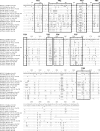Detection and characterization of group C rotaviruses in asymptomatic piglets in Ireland
- PMID: 18632912
- PMCID: PMC2546720
- DOI: 10.1128/JCM.00809-08
Detection and characterization of group C rotaviruses in asymptomatic piglets in Ireland
Abstract
Group C rotaviruses are important human enteric pathogens that have also been detected in a variety of mammalian species, including pigs. Group C rotaviruses have been identified in piglets with diarrhea, but their ecology remains to be elucidated. By screening of 292 fecal samples collected from 4- to 5-week-old asymptomatic pigs from four herds in Ireland between 2005 and 2007, 13 (4.4%) samples tested positive by reverse transcription-PCR for group C rotavirus. Group A rotaviruses were also detected in 19 samples but not in conjunction with group C viruses. The gene encoding the major group C neutralization antigen, the outer capsid protein VP7, was sequenced. The majority of the strains were very closely related to each other (>99% amino acid [aa] identity) and were characterized as genogroup G1 since they were genetically related to the prototype porcine strain Cowden (92.6% aa identity). Conversely, two strains (1GA/05/Cork/Ire and 281/07/Dublin/Ire) were characterized as genogroup G6 since they displayed the highest identity (89.2 to 94.0% aa) to porcine G6 strains (43/06-22-like). Unexpectedly, one such G6 strain, 1GA/05/Cork/Ire, lacked the 4-aa insertion in the VP7 variable region VR8 found in all the other G6 group C rotaviruses. This study provides evidence that porcine group C rotavirus may be detected not infrequently in asymptomatic piglets. In addition, it provides evidence that, unlike the human viruses, porcine group C rotaviruses display broad genetic heterogeneity, which may pose a challenge for the development of prophylactic tools.
Figures


Similar articles
-
Detection and characterisation of group A rotavirus in asymptomatic piglets in southern Ireland.Arch Virol. 2010 Aug;155(8):1247-59. doi: 10.1007/s00705-010-0713-1. Epub 2010 Jun 6. Arch Virol. 2010. PMID: 20526785
-
Prevalence and genetic heterogeneity of porcine group C rotaviruses in nursing and weaned piglets in Ohio, USA and identification of a potential new VP4 genotype.Vet Microbiol. 2013 May 31;164(1-2):27-38. doi: 10.1016/j.vetmic.2013.01.039. Epub 2013 Feb 6. Vet Microbiol. 2013. PMID: 23428382 Free PMC article.
-
Genetic diversity and novel combinations of G4P[19] and G9P[19] porcine rotavirus strains in Thailand.Vet Microbiol. 2013 Jan 25;161(3-4):255-62. doi: 10.1016/j.vetmic.2012.07.036. Epub 2012 Jul 27. Vet Microbiol. 2013. PMID: 22884282
-
Presence and characterization of pig group A and C rotaviruses in feces of Belgian diarrheic suckling piglets.Virus Res. 2016 Feb 2;213:172-183. doi: 10.1016/j.virusres.2015.12.004. Epub 2015 Dec 8. Virus Res. 2016. PMID: 26677793
-
Porcine group A rotaviruses with heterogeneous VP7 and VP4 genotype combinations can be found together with enteric bacteria on Belgian swine farms.Vet Microbiol. 2014 Aug 6;172(1-2):23-34. doi: 10.1016/j.vetmic.2014.04.002. Epub 2014 Apr 13. Vet Microbiol. 2014. PMID: 24837191 Review.
Cited by
-
Longitudinal study of rotavirus C VP6 genotype I6 in diarrheic piglets up to 1 week old.Braz J Microbiol. 2020 Sep;51(3):1345-1351. doi: 10.1007/s42770-020-00234-z. Epub 2020 Jan 30. Braz J Microbiol. 2020. PMID: 31997262 Free PMC article.
-
Evolution of rotavirus C in humans and several domestic animal species.Zoonoses Public Health. 2019 Aug;66(5):546-557. doi: 10.1111/zph.12575. Epub 2019 Mar 7. Zoonoses Public Health. 2019. PMID: 30848076 Free PMC article.
-
Phylogenetic analysis of human group C rotavirus circulating in Brazil reveals a potential unique NSP4 genetic variant and high similarity with Asian strains.Mol Genet Genomics. 2015 Jun;290(3):969-86. doi: 10.1007/s00438-014-0971-9. Epub 2014 Dec 11. Mol Genet Genomics. 2015. PMID: 25501310
-
Detection and genetic diversity of porcine group A rotaviruses in historic (2004) and recent (2011 and 2012) swine fecal samples in Ohio: predominance of the G9P[13] genotype in nursing piglets.J Clin Microbiol. 2013 Apr;51(4):1142-51. doi: 10.1128/JCM.03193-12. Epub 2013 Jan 30. J Clin Microbiol. 2013. PMID: 23363823 Free PMC article.
-
Recent advances in rotavirus reverse genetics and its utilization in basic research and vaccine development.Arch Virol. 2021 Sep;166(9):2369-2386. doi: 10.1007/s00705-021-05142-7. Epub 2021 Jul 3. Arch Virol. 2021. PMID: 34216267 Free PMC article. Review.
References
-
- Arista, S., L. Giovannelli, D. Pistoia, A. Cascio, M. Parea, and G. Gerna. 1990. Electropherotypes, subgroups and serotypes of human rotavirus strains causing gastroenteritis in infants and young children in Palermo, Italy from 1985 to 1989. Res. Virol. 141435-448. - PubMed
-
- Bányai, K., B. Jiang, A. Bogdán, B. Horváth, F. Jakab, E. Meleg, V. Martella, L. Magyari, B. Melegh, and G. Szucs. 2006. Prevalence and molecular characterization of human group C rotaviruses in Hungary. J. Clin. Virol. 37317-322. - PubMed
Publication types
MeSH terms
Associated data
- Actions
- Actions
- Actions
LinkOut - more resources
Full Text Sources
Medical
Research Materials
Miscellaneous

